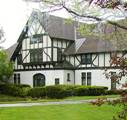
Tudor Revival (1890s – Present)
Heavy chimneys and decorative half-timbering give Tudor style houses a Medieval flavor. The Tudor style is sometimes called Medieval Revival.
History:
The name Tudor suggests that these houses were built in the 1500s, during the Tudor Dynasty in England. But of course, Tudor houses in the United States are modern-day re-inventions and are more accurately called Tudor Revival or Medieval Revival. Some Tudor Revival houses mimic humble Medieval cottages – They may even include a false thatched roof. Other Tudor Revival homes suggest Medieval palaces. They may have overlapping gables, parapets, and beautifully patterned brick or stonework. These historic details combine with Victorian or Craftsman flourishes.
As in many Queen Anne and Stick style homes, Tudor style houses often feature striking decorative timbers. These timbers hint at – but do not reproduce – Medieval construction techniques. In Medieval houses, the timber framing was integral with the structure. Tudor Revival houses, however, merely suggest the structural framework with false half-timbering. This decorative woodwork comes in many different designs, with stucco or patterned brick between the timbers.
In the United States, Tudor styling takes on a variety of forms ranging from elaborate mansions to modest suburban homes with mock masonry veneers. The style became enormously popular in the 1920s and 1930s, and modified versions became fashionable in the 1970s and 1980s.
One popular housing type inspired by inspired by Tudor ideas is the Cotswold Cottage. These quaint homes have an imitation thatched roof, massive chimneys, an uneven sloping roof, small window panes, and low doors.
Features:
Decorative half-timbering
Steeply pitched roof
Prominent cross gables
Tall, narrow windows
Small window panes
Massive chimneys
Next: Cotswold Cottage